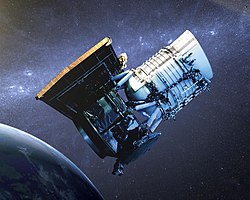വൈഡ് ഫീൽഡ് ഇൻഫ്രാറെഡ് സർവ്വേ എക്സ്പ്ലോറർ
ഇൻഫ്രാറെഡ് കിരണങ്ങൾ ഉപയോഗിച്ച് പ്രവർത്തിക്കുന്ന ഒരു ബഹിരാകാശ ദൂരദർശിനിയാണ് വൈസ് എന്നറിയപ്പെടുന്ന വൈഡ് ഫീൽഡ് ഇൻഫ്രാറെഡ് സർവ്വേ എക്സ്പ്ലോറർ. 2009 ഡിസംബർ മാസത്തിലാണ് ഇത് വിക്ഷേപിച്ചതു്.[1][2][3] ആദ്യമായി Y ഡ്വാർഫ് വിഭാഗത്തിൽ പെടുന്ന നക്ഷത്രത്തെ കണ്ടെത്തിയത് വൈസ് ആണ്. കൂടാതെ ആയിരക്കണക്കിന് ഛിന്നഗ്രഹങ്ങളെയും നക്ഷത്രസമൂഹങ്ങളെയും കണ്ടെത്തി.[4][5][6][7][8][9]
 Wide-field Infrared Survey Explorer | |
| General information | |
|---|---|
| NSSDC ID | 2009-071A |
| Organization | NASA / JPL |
| Major contractors | Ball Aerospace Lockheed Martin Space Dynamics Laboratory SSG Precision Optronics, Inc. |
| Launch date | December 14, 2009 at 14:09:33 UTC |
| Launch site | Vandenberg Air Force Base SLC-2W, Lompoc, California, U.S. |
| Launch vehicle | Delta II 7320-10 |
| Mass | 750 kg (1,650 lb) |
| Type of orbit | Sun-synchronous polar Inclination: 97.5° |
| Orbit height | 525 km (326 mi) |
| Orbit period | 95 minutes, 15 times per day |
| Location | Low Earth Orbit |
| Wavelength | 3.4, 4.6, 12, 22 μm bands |
| Diameter | 0.4 m |
| Website | wise.ssl.berkeley.edu |
ആകാശം മുഴുവൻ ജ്യോതിശാസ്ത്രവിശകലനം നടത്തു വൈസ് 3.4, 4.6, 12, 22 μm എന്നീ തരംഗദൈർഘ്യത്തിലുള്ള ഇമേജുകളാണ് ലഭ്യമാക്കുന്നത്. 40സെ.മീറ്റർ(16 ഇഞ്ച്) ഇൻഫ്രാറെഡ് ദൂരദർശിനിയാണ് ഇതിൽ ഉപയോഗിക്കുന്നത്.[10] ഹൈഡ്രജൻ ശീതീകാരി ഒഴിവാക്കിയതിനു ശേഷം നാലു മാസത്തോളം ഭൂസമീപത്തു കൂടി പോകുന്ന ചെറുസൗരയൂഥപദാർത്ഥങ്ങളെ കുറിച്ചു പഠിക്കുന്നതിനു വേണ്ടി ഉപയോഗപ്പെടുത്തി. നിയോവൈസ് എന്നായിരുന്നു ഈ ദൗത്യത്തിനു നൽകിയ പേര്.[11]
വൈസിന്റെ സർവ്വെയിൽ നിന്നും കിട്ടി വിവരങ്ങളും വിശദാംശങ്ങളും ചിത്രങ്ങളുമെല്ലാം 2012 മാർച്ച് 12൹ പൊതുജനങ്ങൾക്കായി സമർപ്പിച്ചു.[12][13][14][15] 2013 ആഗസ്റ്റ് മാസത്തിൽ വൈസ് ദൗത്യം പുനരുജ്ജീവിപ്പിച്ചതായി നാസ വെളിപ്പെടുത്തി. മൂന്നു വർഷത്തേക്കു കൂടിയാണ് ഇങ്ങനെ കാലാവധി നീട്ടിക്കിട്ടിയത്. ഭൂമിയുമായി കൂട്ടിയിടിക്കാൻ സാധ്യതയുള്ള ഛിന്നഗ്രഹങ്ങളെ കണ്ടെത്തുക എന്നതാണ് ഇതിന്റെ പുതിയ ദൗത്യം.[16]
അവലംബം
തിരുത്തുക- ↑ Ray, Justin (December 14, 2008). "Mission Status Center: Delta/WISE". Spaceflight Now. Retrieved December 26, 2009.
- ↑ Rebecca Whatmore; Brian Dunbar (December 14, 2009). "WISE". NASA. Archived from the original on 2009-11-09. Retrieved December 26, 2009.
{{cite web}}: CS1 maint: multiple names: authors list (link) - ↑ Clavin, Whitney (December 14, 2009). "NASA's WISE Eye on the Universe Begins All-Sky Survey Mission". NASA Jet Propulsion Laboratory. Archived from the original on 2009-12-18. Retrieved December 26, 2009.
- ↑ "Wide-field Infrared Survey Explorer". Astro.ucla.edu. Retrieved 2013-08-24.
- ↑ "JPL – NASA's WISE Finds Earth's First Trojan Asteroid (July 27, 2011)". Jpl.nasa.gov. 2011-07-27. Archived from the original on 2012-06-07. Retrieved 2013-08-24.
- ↑ "Berkeley – NASA's WISE Finds Earth's First Trojan Asteroid (July 27, 2011)". Wise.ssl.berkeley.edu. Retrieved 2013-08-24.
- ↑ "WISE Public Web Site – UCLA". Astro.ucla.edu. Retrieved 2013-08-24.
- ↑ Morse, Jon. "Discovered: Stars as Cool as the Human Body". Archived from the original on 2011-10-07. Retrieved August 24, 2011.
- ↑ Majaess, D. (2013). Discovering protostars and their host clusters via WISE, ApSS, 344, 1
- ↑ "Wide-field Infrared Survey Explorer (WISE)". Astro.ucla.edu. Retrieved 2013-08-24.
- ↑ Debra Werner (October 5, 2010). "Last-minute Reprieve Extends WISE Mission". Space News. Archived from the original on 2012-12-09. Retrieved October 29, 2010.
- ↑ "WISE All-Sky Data Release". Wise2.ipac.caltech.edu. Retrieved 2013-08-24.
- ↑ "NASA Releases New WISE Mission Catalog of Entire Infrared Sky". Nasa.gov. Archived from the original on 2012-03-16. Retrieved 2013-08-24.
- ↑ Clavin, Whitney (July 18, 2011). "Can WISE Find the Hypothetical 'Tyche'?". NASA.gov. Archived from the original on 2011-02-21. Retrieved July 19, 2011.
- ↑ "The Wide-field Infrared Survey Explorer All-Sky Data Release March 14, 2012". The Wide-field Infrared Survey Explorer at IPAC. Retrieved March 17, 2012.
- ↑ Reuters (August 22, 2013). "NASA space telescope rebooted as asteroid hunter". CBC News. Retrieved August 22, 2013.
{{cite news}}:|author=has generic name (help)